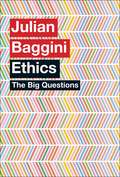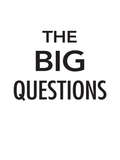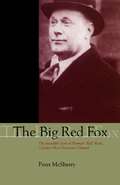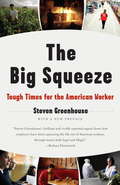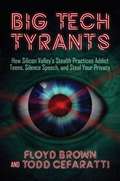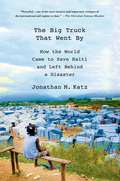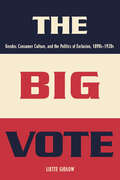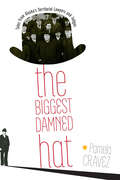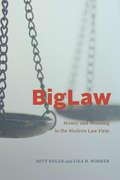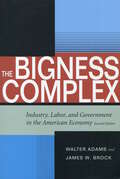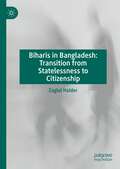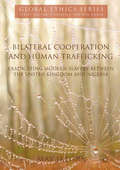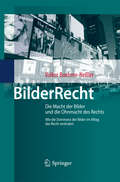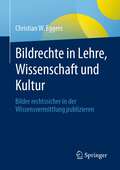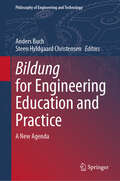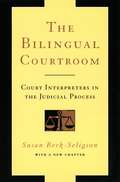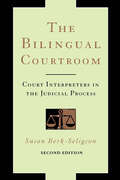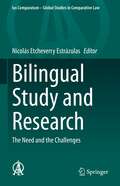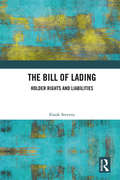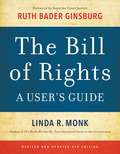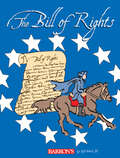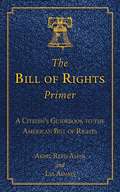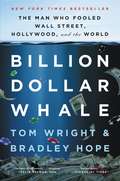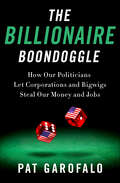- Table View
- List View
The Big Questions: Ethics
by Julian Baggini'The Big Questions' series is designed to let renowned experts confront the 20 most fundamental and frequently asked questions of a major branch of science or philosophy. In 'The Big Questions: Ethics' Julian Baggini, one of Britain's best-known philosophers, condenses complex, contemporary issues of right and wrong into 20 key questions. He examines how we can start to answer them, what they might mean to us and how they influence the way we choose to live our lives. Among the ideas debated are: What is free will? Can it ever be right to kill? Is terrorism ever justified? Should euthanasia be legal? Are some people superior to others? Do animals have rights?
The Big Questions: Tackling the Problems of Philosophy with Ideas from Mathematics, Economics and Physics
by Steven E. LandsburgIn the wake of his enormously popular books The Armchair Economist and More Sex Is Safer Sex, Steven Landsburg uses concepts from mathematics, economics, and physics to address the big questions in philosophy: What is real? What can we know? What is the difference between right and wrong? And how should we live? Widely renowned for his lively explorations of economics, in his fourth book Landsburg branches out into mathematics and physics as well—disciplines that, like economics, the author loves for their beauty, their logical clarity, and their profound and indisputable truth—to take us on a provocative and utterly entertaining journey through the questions that have preoccupied philosophers through the ages. The author begins with the broadest possible categories—Reality and Unreality; Knowledge and Belief; Right and Wrong—and then focuses his exploration on specific concerns: from a mathematical analysis of the arguments for the existence of God; to the real meaning of the Heisenberg Uncertainty Principle and the Godel Incompleteness Theorem; to the moral choices we face in the marketplace and the voting booth. Stimulating, illuminating, and always surprising, The Big Questions challenges readers to re-evaluate their most fundamental beliefs and reveals the relationship between the loftiest philosophical quests and our everyday lives.
The Big Red Fox: The Incredible Story of Norman "Red" Ryan, Canada's Most Notorious Criminal
by Peter McsherryShort-listed for the 2000 Arthur Ellis Award for Best Non-Fiction Norman "Red" Ryan was a notorious bank robber, safecracker, and killer. He escaped from Kingston Penitentiary twice - first by force, and then years later by gulling the credulous into believing that he was "reformed." The dupes of Ryan’s second emancipation included the prison’s Roman Catholic chaplain, several nationally prominent citizens, the country’s largest newspaper, and, ultimately, R.B. Bennett, the prime minister of Canada, who made the mistake of arranging a "political parole" for Ryan. Six people - three of them innocent victims - died as a result of Red Ryan’s freedom. Dubbed "the Jesse James of Canada" and "Canada’s most notorious criminal," Ryan had compiled a record of nineteen convictions for crimes of theft and violence, and had been in nine shooting affrays with police and citizens. He was a "lifer" in an era when "life" meant just that. Yet he got out of Kingston after just eleven and a half years and returned to Toronto, the city of his birth, amid fanfare befitting a national hero. His death in a liquor store robbery in Sarnia on May 23, 1936, just ten months after his release, was a huge jolt to Canada, and especially Toronto. How could such an obvious threat to society be paroled from prison as a paragon of reform? This question is central to The Big Red Fox. The answer lies not with Ryan himself - not even the cunning and deceitful Red Ryan could have hoodwinked his way out of a life sentence - but with those who helped him, and who benefited from his release.
The Big Squeeze: Tough Times for the American Worker
by Steven GreenhouseWhy, in the world's most affluent nation, are so many corporations squeezing their employees dry? In this fresh, carefully researched book, New York Times reporter Steven Greenhouse explores the economic, political, and social trends that are transforming America's workplaces, including the decline of the social contract that created the world's largest middle class and guaranteed job security and good pensions. We meet all kinds of workers--white-collar and blue-collar, high-tech and low-tech, middle-class and low-income--as we see shocking examples of injustice, including employees who are locked in during a hurricane or fired after suffering debilitating, on-the-job injuries. With pragmatic recommendations on what government, business and labor should do to alleviate the economic crunch, The Big Squeeze is a balanced, consistently revealing look at a major American crisis.
Big Tech Tyrants: How Silicon Valley's Stealth Practices Addict Teens, Silence Speech, and Steal Your Privacy
by Floyd Brown Todd CefarattiThey are driven without respect for the lives they are changing…“Boy Kings,” or Big Tech Tyrants, are considered the most powerful individuals in the world. They’re the autocratic aristocrats who run the tech giants in Silicon Valley, and if the labels are accurate, they suggest these social platform operators have gained a non-elected (or, should we say, a self-elected) authoritarian power. They wield it with more effectiveness and precision than any sitting government or military strategist. Big Tech Tyrants boast riches beyond emperors of old but act like juveniles who don’t want to grow up. They are modern-day robber barons. Big Tech Tyrants don’t know the meaning of privacy, when it comes to you. They try to make you believe they will give their products away for free as a service to society, when really, they are vacuuming your personal data. They use this data to discover your deepest secrets. Are you or your partner trying to get pregnant? Are you underwater financially? Are you having an extramarital affair? Do you have a tidy nest egg? Are you a Trump supporter? Are you a Bernie Sanders follower? Are you a Scientologist, Mormon, Christian, or Buddhist? Your personal data is extremely valuable to them—and they use it—and abuse. These tyrants knowingly addict users to make more money. Not only that, they also consider themselves the most enlightened the world has ever seen—so they know what’s best for you to see—from the news and information you read to the political candidates they think you should vote for. They censor news and only let you see what they want you to see. This is an eye-opening must read for anyone living in the twenty-first century!
The Big Truck That Went By: How the World Came to Save Haiti and Left Behind a Disaster
by Jonathan M. KatzOn January 12, 2010, the deadliest earthquake in the history of the Western Hemisphere struck the nation least prepared to handle it. Jonathan M. Katz, the only full-time American news correspondent in Haiti, was inside his house when it buckled along with hundreds of thousands of others. In this visceral, authoritative first-hand account, Katz chronicles the terror of that day, the devastation visited on ordinary Haitians, and how the world reacted to a nation in need. More than half of American adults gave money for Haiti, part of a monumental response totaling $16. 3 billion in pledges. But three years later the relief effort has foundered. It's most basic promises-to build safer housing for the homeless, alleviate severe poverty, and strengthen Haiti to face future disasters-remain unfulfilled. The Big Truck That Went By presents a sharp critique of international aid that defies today's conventional wisdom; that the way wealthy countries give aid makes poor countries seem irredeemably hopeless, while trapping millions in cycles of privation and catastrophe. Katz follows the money to uncover startling truths about how good intentions go wrong, and what can be done to make aid "smarter. " With coverage of Bill Clinton, who came to help lead the reconstruction; movie-star aid worker Sean Penn; Wyclef Jean; Haiti's leaders and people alike, Katz weaves a complex, darkly funny, and unexpected portrait of one of the world's most fascinating countries. The Big Truck That Went By is not only a definitive account of Haiti's earthquake, but of the world we live in today.
The Big Vote: Gender, Consumer Culture, and the Politics of Exclusion, 1890s–1920s (Reconfiguring American Political History)
by Liette GidlowLow voter turnout is a serious problem in American politics today, but it is not a new one. Its roots lay in the 1920s when, for the first time in nearly a century, a majority of eligible Americans did not bother to cast ballots in a presidential election. Stunned by this civic failure so soon after a world war to "make the world safe for democracy," reforming women and business men launched massive campaigns to "Get Out the Vote." By 1928, they had enlisted the enthusiastic support of more than a thousand groups in Forty-six states. In The Big Vote, historian Liette Gidlow shows that the Get-Out-the-Vote campaigns—overlooked by historians until now—were in fact part of an important transformation of political culture in the early twentieth century. Weakened political parties, ascendant consumer culture, labor unrest, Jim Crow, widespread anti-immigration sentiment, and the new woman suffrage all raised serious questions about the meanings of good citizenship. Gidlow recasts our understandings of the significance of the woman suffrage amendment and shows that it was important not only because it enfranchised women but because it also ushered in a new era of near-universal suffrage. Faced with the apparent equality of citizens before the ballot box, middle-class and elite whites in the Get-Out-the-Vote campaigns and elsewhere advanced a searing critique of the ways that workers, ethnics, and sometimes women behaved as citizens. Through techniques ranging from civic education to modern advertising, they worked in the realm of culture to undo the equality that constitutional amendments had seemed to achieve. Through their efforts, by the late 1920s, "civic" had become practically synonymous with "middle class" and "white." Richly documented with primary sources from political parties and civic groups, popular and ethnic periodicals, and electoral returns, The Big Vote looks closely at the national Get-Out-the-Vote campaigns and at the internal dynamics of campaigns in the case-study cities of New York, New York, Grand Rapids, Michigan, and Birmingham, Alabama. In the end, the Get-Out-the Vote campaigns shed light not only on the problem of voter turnout in the 1920s, but on some of the problems that hamper the practice of full democracy even today.
The Biggest Damned Hat: Tales from Alaska's Territorial Lawyers and Judges
by Pamela CravezAlaska history from the days before statehood is rich in stories of colorful characters—prospectors, settlers, heroes, and criminals. And right alongside them were judges and lawyers, working first to establish the rule of law in the territory, then, later, laying the groundwork for statehood. The Biggest Damned Hat presents a fascinating collection of stories ranging from the gold rush to the 1950s. Built on interviews and oral histories from more than fifty lawyers who worked in Alaska before 1959, and buttressed by research into legal history, the book offers a brilliantly multifaceted portrait of law in the territory—from laying the groundwork for strong civil and criminal law to helping to secure mining and fishing rights to the Alaska Court-Bar fight, which pitted Alaska’s community of lawyers against its nascent Supreme Court. Bringing to life a time long past—when some of the best lawyers had little formal legal education—The Biggest Damned Hat fills in a crucial part of the story of Alaska’s history.
BigLaw: Money and Meaning in the Modern Law Firm (Chicago Series in Law and Society)
by Mitt Regan Lisa H. RohrerThe Great Recession intensified large law firms’ emphasis on financial performance, leading to claims that lawyers in these firms were now guided by business rather than professional values. Based on interviews with more than 250 partners in large firms, Mitt Regan and Lisa H. Rohrer suggest that the reality is much more complex. It is true that large firm hiring, promotion, compensation, and termination policies are more influenced by business considerations than ever before and that firms actively recruit profitable partners from other firms to replace those they regard as unproductive. At the same time, law firm partners continue to seek the non-financial rewards of being members of a distinct profession and are sensitive to whether their firms are committed to providing them. Regan and Rohrer argue that modern firms responding effectively to business demands while credibly affirming the importance of non-financial professional values can create strong cultures that enhance their ability to weather the storms of the modern legal market.
The Bigness Complex: Industry, Labor, and Government in the American Economy, Second Edition
by Walter Adams James W. BrockThe Bigness Complex confronts head-on the myth that organizational giantism leads to economic efficiency and well-being in the modern age. On the contrary, it demonstrates how bigness undermines our economic productivity and progress, endangers our democratic freedoms, and exacerbates our economic problems and challenges. This new edition has a thoroughly updated variety of issues, examples, and new developments, including government bailouts of the airline industry; regulation of biotechnology; the fiasco of recent electricity deregulation; and mergers and consolidations in oil, radio, and grocery retailing. The analysis is framed in the timeless context of American distrust of concentrations of power. The authors show how both the left and the right fail to address the central problem of power in formulating their diagnoses and recommendations. The book concludes with an alternative public philosophy as a viable guidepost for public policy toward business in a free-enterprise democracy.
Biharis in Bangladesh: Transition from Statelessness to Citizenship
by Zaglul HaiderThis book deals with the citizenship status of the Biharis in Bangladesh and their ability to access rights associated with citizenship. The main argument of the book is that although legally the Biharis are citizens of Bangladesh, they still do not have access to many important rights of citizenship that can make their citizenship meaningful. Their inability to access many important citizenship rights made them de facto stateless, although they are de-jure citizens. Taking a law and society approach this book examines both legal and non-legal factors behind the deplorable conditions of the Biharis in Bangladesh. Based on fieldwork, this book analyses that the Biharis’ inability to access citizenship rights is inconsistent with citizenship theory, citizenship laws, and the Constitution of Bangladesh. To make the Biharis citizenship effective or meaningful the author suggests some recommendations for policy changes that would enable Biharis to access rights associated with citizenship.
Bilateral Cooperation and Human Trafficking: Eradicating Modern Slavery between the United Kingdom and Nigeria (Global Ethics)
by May IkeoraThis book presents a case study of human trafficking from Nigeria to the UK, with a focus on practical measures for ending this trafficking. The study addresses the many aspects of human trafficking, including sexual exploitation, domestic servitude, labor exploitation, benefit fraud, and organ harvesting. Despite the huge investment of the international community to eradicate it, this form of modern day slavery continues, and the author urges stakeholders to focus not only on criminals but also on attitudes, cultures, laws and policies that hinder the eradication of modern slavery.
BilderRecht: Die Macht der Bilder und die Ohnmacht des Rechts Wie die Dominanz der Bilder im Alltag das Recht verändert
by Volker Boehme-NeßlerWir leben in einer Bilderwelt. Die Folgen sind - im wahrsten Sinn des Worts - unübersehbar. Was bedeutet die Dominanz der Bilder für das Recht? Bisher ist das Recht sehr bilderskeptisch. Das wird kaum so bleiben können, denn wenn sich ein Recht zu weit vom Leben entfernt, wird es über kurz oder lang an Bedeutung verlieren. Welche Chancen und Risiken ergeben sich, wenn Parlamente, Verwaltungen, Gerichte und Anwälte visuell kommunizieren? Der Autor diskutiert die Frage, wie ein BilderRecht aussehen könnte.
Bildrechte in Lehre, Wissenschaft und Kultur: Bilder rechtssicher in der Wissensvermittlung publizieren
by Christian W. EggersBildliche Darstellungen sind ein wichtiger Bestandteil in der Wissensvermittlung. Bildnutzungen zur Lehre, Bewahrung der Kultur und der Forschung sowie der Wissenschaft unterliegen besonderen Regelungen durch das Urheberrecht. Unter welchen rechtlichen Voraussetzungen können Grafiken, Videos und Fotos von Lehrenden und den Mitarbeitenden der Einrichtungen zur Wissenschaft und Kultur publiziert und zur Kommunikation verwendet werden? Welche Reglungen gelten bei der Nutzung fremder Werke in wissenschaftlichen Arbeiten? Hierauf gibt dieses Buch Antworten. Im Zuge der 2018 neu geschaffenen urheberrechtlichen Regelungen zur „Wissensgesellschaft“ und zuletzt mit der 2021 Geltung erlangten Urheberrechtsreform ergeben sich eine Reihe von rechtlichen Erleichterungen und Klarstellungen bei der Nutzung von Grafiken, Videos und Fotografien. Insbesondere wurden Regelungen für die digitale Kommunikation im lehrenden und wissenschaftlichen Kontext neu geschaffen und ergänzt. Dieser Ratgeber zum Urheberrecht richtet sich vor allem an Publizierende, die Grafiken, Videos und Fotos zum Zwecke der Forschung, Lehre und zur Außendarstellung kultureller Einrichtungen nutzen. Damit dient das Buch als Wissensressource in der praktischen Arbeit der Mitarbeitenden der Universitäten, Museen, Bibliotheken sowie Forschungsstellen und den Archiven zur Bewahrung von Kulturgut.Mit der Entwicklung der Wissensgesellschaft steigt das Bedürfnis der publizierenden Einrichtungen aus Kultur, Wissenschaft und Lehre Werke der Bildung und Kultur über das Internet der Allgemeinheit frei zur Verfügung zu stellen. Einen weiteren Schwerpunkt dieses Buches bilden daher die urheberrechtlichen Fragen von Publikationen unter Open-Science-Bedingungen
Bildung for Engineering Education and Practice: A New Agenda (Philosophy of Engineering and Technology #49)
by Steen Hyldgaard Christensen Anders BuchUsing the concept of Bildung as a framework, which in late capitalism/postmodernity may be perceived to include critical knowledge, value consciousness, ethics, and social responsibility (including sustainability), this project aims to investigate the underlying aspirations, structures, and dynamics of change taking place in engineering education and practice through conversations between engineering, social sciences, and the humanities. Calling upon the spirit of philosophers on Bildung such as John Dewey, Jürgen Habermas and contemporaries, the focus of the present project is on broadening engineering education initiatives and practice that follow normative understandings of Bildung. This volume appeals to researchers and students working in philosophy, engineering, and education.
The Bilingual Courtroom: Court Interpreters in the Judicial Process
by Susan Berk-SeligsonDrawing on more than one hundred hours of taped recordings of Spanish/English court proceedings in federal, state, and municipal courts—along with extensive psycholinguistic research using translated testimony and mock jurors—Susan Berk-Seligson's seminal book presents a systematic study of court interpreters, and raises some alarming, vitally important concerns: contrary to the assumption that interpreters do not affect the contents of court proceedings, they could potentially make the difference between a defendant being found guilty or innocent of a crime.
The Bilingual Courtroom: Court Interpreters in the Judicial Process, Second Edition
by Susan Berk-SeligsonSusan Berk-Seligson’s groundbreaking book draws on more than one hundred hours of audio recordings of Spanish/English court proceedings in federal, state, and municipal courts—along with a number of psycholinguistic experiments involving mock juror reactions to interpreted testimony—to present a systematic study of court interpreters that raises some alarming, vitally important concerns. Contrary to the assumption that interpreters do not affect the dynamics of court proceedings, Berk-Seligson shows that interpreters could potentially make the difference between a defendant being found guilty or not guilty of a crime. This second edition of the The Bilingual Courtroom includes a fully updated review of both theoretical and policy-oriented research relevant to the use of interpreters in legal settings, particularly from the standpoint of linguistic pragmatics. It provides new insights into interpreting in quasi-judicial, informal, and specialized judicial settings, such as small claims court, jails, and prisons; updates trends in interpreter certification and credentialing, both in the United States and abroad; explores remote interpreting (for example, by telephone) and interpreter training programs; looks at political trials and tribunals to add to our awareness of international perspectives on court interpreting; and expands upon cross-cultural issues. Also featuring a new preface by Berk-Seligson, this second edition not only highlights the impact of the previous versions of The Bilingual Courtroom, but also draws attention to the continued need for critical study of interpreting in our ever diversifying society.
Bilingual Study and Research: The Need and the Challenges (Ius Comparatum - Global Studies in Comparative Law #58)
by Nicolás Etcheverry EstrázulasThis book addresses the importance of bilingualism in legal education. Written by respected experts in the field, it presents reports on bilingual legal education in countries with such diverse cultures and histories as Belgium, Canada, China, the Czech Republic, Finland, France, Germany, Italy, Japan, Mexico, Romania, Singapore, Taiwan and the USA. The findings are also summarized in a General Report that was presented at the 20th IACL General Congress in Fukuoka, Japan.
The Bill of Lading: Holder Rights and Liabilities
by Frank StevensThe carriage of goods by sea starts off with a contract of carriage, an essentially simple and straightforward contract between two parties, the shipper and the carrier. Very often, however, a bill of lading is issued and a third party appears on the scene: the holder of the bill of lading. The holder was not involved in the making of the contract of carriage, but does have rights, and possibly obligations, against the carrier at destination. The question then is how the third-party holder of the bill acquires those rights and obligations. Analysing the different theories that have been proposed to explain the position of the third party holder, this book makes a distinction between contractual theories and non-contractual theories to explain the holder's position. Contractual theories build on the initial contract of carriage and apply contract law mechanisms while non-contractual theories construe the position of the third-party holder independently. Following the analysis and appraisal of the different theories, this book makes the case that the position of the third-party holder of the bill of lading is not obvious or self-evident; and submits that a statutory approach to the position of the holder of the bill of lading has advantages and would be preferable.
The Bill of Rights: A User's Guide
by Ruth Bader Ginsburg Linda R MonkWith a foreword by Justice Ruth Bader Ginsburg of the U.S. Supreme Court.An Engaging, Accessible Guide to the Bill of Rights for Everyday Citizens.In The Bill of Rights: A User's Guide, award-winning author and constitutional scholar Linda R. Monk explores the remarkable history of the Bill of Rights amendment by amendment, the Supreme Court's interpretation of each right, and the power of citizens to enforce those rights.Stories of the ordinary people who made the Bill of Rights come alive are featured throughout. These include Fannie Lou Hamer, a Mississippi sharecropper who became a national civil rights leader; Clarence Earl Gideon, a prisoner whose handwritten petition to the Supreme Court expanded the right to counsel; Mary Beth Tinker, a 13-year-old whose protest of the Vietnam War established free speech rights for students; Michael Hardwick, a bartender who fought for privacy after police entered his bedroom unlawfully; Suzette Kelo, a nurse who opposed the city's takeover of her working-class neighborhood; and Simon Tam, a millennial whose 10-year trademark battle for his band "The Slants" ended in a unanimous Supreme Court victory. Such people prove that, in the words of Judge Learned Hand, "Liberty lies in the hearts of men and women; when it dies there, no constitution, no law, no court, can save it."Exploring the history, scope, and meaning of the first ten amendments-as well as the Fourteenth Amendment, which nationalized them and extended new rights of equality to all-The Bill of Rights: A User's Guide is a powerful examination of the values that define American life and the tools that every citizen needs. Winner of the American Bar Association's Silver Gavel Award, its highest honor for media about the law.
The Bill of Rights: Protecting Our Freedom Then and Now
by Syl Sobel J.D.This easy-to-read book about the United States for kids brings history and social studies classes to life as readers learn about the Bill of Rights, how they came to be, and what they mean. Here is a book that will be valued by teachers and enjoyed by young students.Parents, teachers, and gift givers will find:a clear explanation of each of the amendmentsfascinating facets of American constitutional history and lawa book that makes the Bill of Rights relevant to kids' livesBy 1787, the leaders of America's 13 newly-created states that had just won their independence from Britain convened to draw up the Constitution of the United States. However, citizens of many of the states feared that a new American government could take away certain of their rights, just as the British had done when they were colonies. It was soon agreed to add a series of ten amendments to the Constitution in order to guarantee specific rights to all citizens and states.
The Bill of Rights in the Modern State
by Geoffrey R. Stone Richard A. Epstein Cass R. SunsteinPapers from a symposium at the University of Chicago celebrating the bicentennial of the Bill of Rights.
The Bill of Rights Primer: A Citizen's Guidebook to the American Bill of Rights
by Akhil Reed Amar Les AdamsMany Americans reference the Bill of Rights, a document that represents many of the freedoms that define the United States. Who doesn't know about the First Amendment's freedom of religion or Second Amendment's right to bear arms? In this pocket-sized volume, Akhil Reed Amar and Les Adams offer a wealth of knowledge about the Bill of Rights that goes beyond a basic understanding.The Bill of Rights Primer is an authoritative guide to all American freedoms. Uncluttered and well-organized, this text is perfect for those who want to study up on the Bill of Rights without needing a law degree to do so.This elementary guidebook presents a short historical survey of the people, events, decrees, legislation, writings, and cultural milestones, in England and the American colonies, that influenced the Founding Fathers as they drafted the U.S. Constitution and Bill of Rights. With helpful comments and fun facts in the margins, the book will provide a deeper understanding of the Bill of Rights, exhibiting that it is not a stagnant document but one with an evolving meaning shaped by historical events, such as the American Civil War and Reconstruction.
Billion Dollar Whale: The Man Who Fooled Wall Street, Hollywood, and the World
by Tom Wright Bradley HopeThe definitive inside account of the "extraordinary" (Financial Times) 1MDB scandal, "a true life thriller" (Ben Mezrich) about a "modern Gatsby" who managed to swindle over $5 billion with the aid of Goldman Sachs and others--a "must read" (Booklist) "epic tale" (Publishers Weekly) that exposes the secret nexus of elite wealth, banking, Hollywood, and politics from two award-winning Wall Street Journal reporters. <P><P>In 2009, with the dust yet to settle on the financial crisis, a baby-faced, seemingly mild-mannered Wharton grad began setting in motion a fraud of unprecedented gall and magnitude--one that would come to symbolize the next great threat to the global financial system. His name is Jho Low, a man whose behavior was so preposterous he might seem made up. <P><P> An epic true-tale of hubris and greed, Billion Dollar Whale reveals how this young social climber pulled off one of the biggest heists in history--right under the nose of the global financial industry. <P><P>Federal agents who helped unravel Bernie Madoff's Ponzi scheme say the 1MDB affair will become the textbook case of financial fraud in the modern age--and its fallout is already being credited for taking down the prime minister of Malaysia. With his yacht and private jet reportedly seized by authorities and facing money-laundering charges in Malaysia, an Interpol red notice, and an ongoing U.S. Department of Justice Investigation, Low has become an international fugitive. <P><P>For readers of Liar's Poker, Den of Thieves, and Bad Blood, Billion Dollar Whale will become a classic, harrowing parable about finance run amok. <P><b>A New York Times Bestseller</b>
The Billionaire Boondoggle: How Our Politicians Let Corporations and Bigwigs Steal Our Money and Jobs
by Pat Garofalo"An alarming, fact-driven jeremiad urging change and action." –KirkusThe first comprehensive look at how politicians let the entertainment industry bilk taxpayers, hijack public policy and hurt economic investment, starting and ending with Trump. From stadiums and movie productions to casinos and mega-malls to convention centers and hotels, cities and states have paid out billions of dollars in tax breaks, subsidies, and grants to the world's corporate titans. They hope to boost their economies, create new and better jobs, and lure well-known events such as the Super Bowl--not to mention give their officials the chance to meet celebrities. That Big Entertainment drives bigger economies is a myth, however. Overwhelming evidence shows catering public policy to its promises results in a raw deal for the taxpaying public.In The Billionaire Boondoggle, Garofalo takes readers on a tour of publicly-subsidized corporate America to explain how that myth came to be, how much money America's elected officials throw away, and why courting Big Entertainment just courts disaster. You’ll learn how Maryland gave millions of dollars to Netflix to make House of Cards, and Nevada spent hundreds of millions on a new home for the NFL’s Raiders. New Mexico paid big money to host The Avengers, while city after city fell prey to the debt trap that is the Olympics. You’ll see how big sporting goods stores like Bass Pro Shops and big casinos across the country all get in on the subsidy scam. And you’ll see how many cities got in bed with hotel titans, including Donald J. Trump himself.This book is the go-to guide for the many ways in which American taxpayers unknowingly subsidize the TV shows they watch, the sports teams they root for and the hotels they sleep in, all based on an economic theory that only adds up for CEOs and bigwigs.
